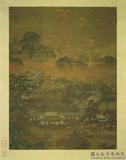五代後蜀黃筌竹梅寒雀圖 軸
推薦分享
資源連結
連結到原始資料 (您即將開啟新視窗離開本站)後設資料
- 資料識別:
- 故畫001785N000000000
- 資料類型:
- 類型:繪畫
- 型式:靜態圖像
- 著作者:
- 黃筌
- 主題與關鍵字:
- 冬景(雪景) 八哥(鴝鵒) 梅(白.紅.蠟梅) 竹 麻雀 桑鳲 山雀 黃尾鴝 朱連雀
- 出版者:
- 數位化執行單位:國立故宮博物院
- 格式:
- 本幅 43.8x62.9公分、全幅 80.4公分
- 關聯:
- 故宮書畫錄(卷八),第四冊,頁54&*故宮書畫圖錄,第一冊,頁121-122&*雪寒中,朱連雀、桑鳲、八哥、麻雀棲於梅竹枝蔓中,此項題材、布景,可見於「邊文進三友百禽」。從畫幅橫大於縱,與一般立軸縱大於橫,有所不同,或許原本為一大畫幅,因殘破割裂而成者。畫中綠竹竿,每節以重筆勾勒,連節處虛空,這種畫法,亦見於邊氏作風。八哥羽毛,其墨黑如碳,一般是以燈炱加膠所成,枝幹留有殘雪,用破筆沾白粉戳出,其法亦見於呂紀諸畫中。就風格論,本畫出於明人,為邊文進、呂紀一系畫家所作。&* In a wintry snow scene, a waxwing, grosbeaks, one mynah, and sparrows perch on the bamboo and plum branches. This subject matter is comparable to that in The Three Friends and One Hundred Birds by Pien Wen-chin. The artist has used a horizontal format for this painting which differs markedly from the usual hanging scroll format. Perhaps the painting in its original state was a large composition which has been cut down. The nodes of the bamboo are outlined with heavy brushwork, and the spaces between the nodes are unpainted, a trait characteristic of Pien Wen-chin. The artist has used charcoal black ink, a substance made of lamp black and glue, for the feathers of the mynah. He also used a worn brush dipped in white powder to dab small white specks onto the branches to signify snow. This is a technique which Lü Chi employed in most of his paintings. According to stylistic analysis, this painting was executed by a Ming dynasty (1368-1644) artist who imitated the style of Pien Wen-chin and Lü Chi.&*1.譚怡令,〈五代後蜀黃筌竹梅寒雀〉,收入譚怡令編,《呂紀花鳥畫特展》(臺北:國立故宮博物院,1995年初版),頁100-101。
- 管理權:
- 國立故宮博物院
授權聯絡窗口
- 國立故宮博物院圖像授權、出版授權、影音資料授權-申請流程說明
http://www.npm.gov.tw/zh-TW/Article.aspx?sNo=03003061






